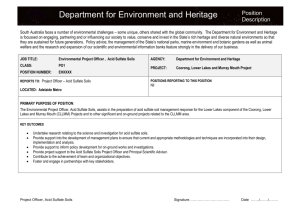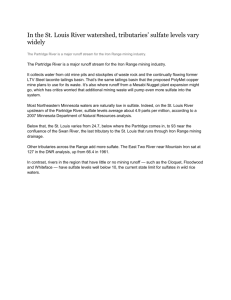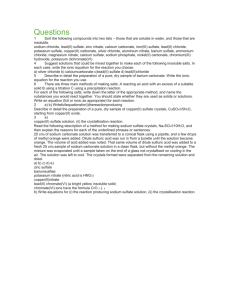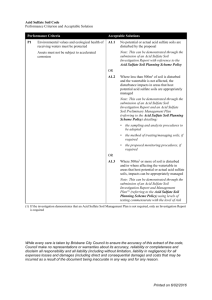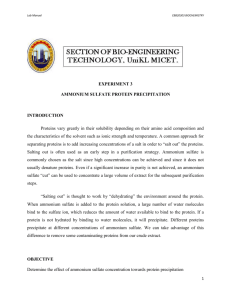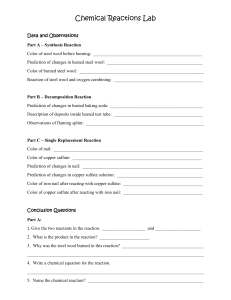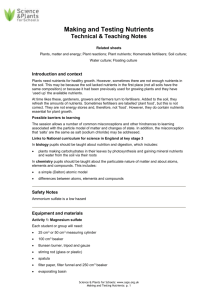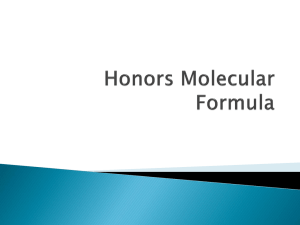Main Proposal - Minnesota Senate
advertisement
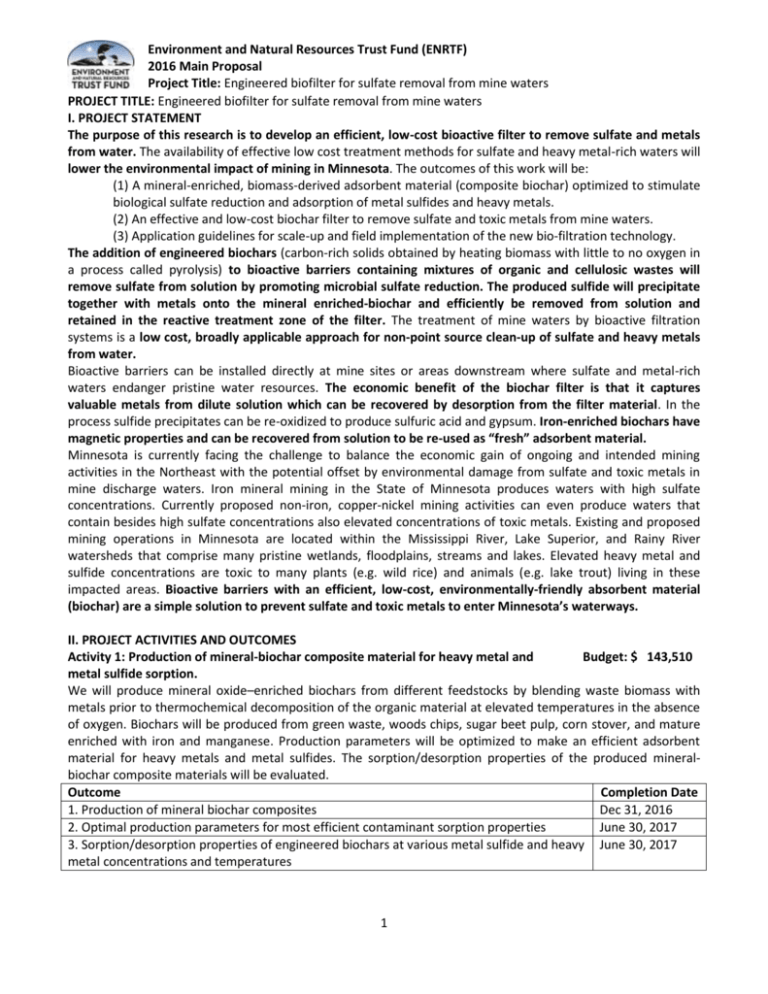
Environment and Natural Resources Trust Fund (ENRTF) 2016 Main Proposal Project Title: Engineered biofilter for sulfate removal from mine waters PROJECT TITLE: Engineered biofilter for sulfate removal from mine waters I. PROJECT STATEMENT The purpose of this research is to develop an efficient, low-cost bioactive filter to remove sulfate and metals from water. The availability of effective low cost treatment methods for sulfate and heavy metal-rich waters will lower the environmental impact of mining in Minnesota. The outcomes of this work will be: (1) A mineral-enriched, biomass-derived adsorbent material (composite biochar) optimized to stimulate biological sulfate reduction and adsorption of metal sulfides and heavy metals. (2) An effective and low-cost biochar filter to remove sulfate and toxic metals from mine waters. (3) Application guidelines for scale-up and field implementation of the new bio-filtration technology. The addition of engineered biochars (carbon-rich solids obtained by heating biomass with little to no oxygen in a process called pyrolysis) to bioactive barriers containing mixtures of organic and cellulosic wastes will remove sulfate from solution by promoting microbial sulfate reduction. The produced sulfide will precipitate together with metals onto the mineral enriched-biochar and efficiently be removed from solution and retained in the reactive treatment zone of the filter. The treatment of mine waters by bioactive filtration systems is a low cost, broadly applicable approach for non-point source clean-up of sulfate and heavy metals from water. Bioactive barriers can be installed directly at mine sites or areas downstream where sulfate and metal-rich waters endanger pristine water resources. The economic benefit of the biochar filter is that it captures valuable metals from dilute solution which can be recovered by desorption from the filter material. In the process sulfide precipitates can be re-oxidized to produce sulfuric acid and gypsum. Iron-enriched biochars have magnetic properties and can be recovered from solution to be re-used as “fresh” adsorbent material. Minnesota is currently facing the challenge to balance the economic gain of ongoing and intended mining activities in the Northeast with the potential offset by environmental damage from sulfate and toxic metals in mine discharge waters. Iron mineral mining in the State of Minnesota produces waters with high sulfate concentrations. Currently proposed non-iron, copper-nickel mining activities can even produce waters that contain besides high sulfate concentrations also elevated concentrations of toxic metals. Existing and proposed mining operations in Minnesota are located within the Mississippi River, Lake Superior, and Rainy River watersheds that comprise many pristine wetlands, floodplains, streams and lakes. Elevated heavy metal and sulfide concentrations are toxic to many plants (e.g. wild rice) and animals (e.g. lake trout) living in these impacted areas. Bioactive barriers with an efficient, low-cost, environmentally-friendly absorbent material (biochar) are a simple solution to prevent sulfate and toxic metals to enter Minnesota’s waterways. II. PROJECT ACTIVITIES AND OUTCOMES Activity 1: Production of mineral-biochar composite material for heavy metal and Budget: $ 143,510 metal sulfide sorption. We will produce mineral oxide–enriched biochars from different feedstocks by blending waste biomass with metals prior to thermochemical decomposition of the organic material at elevated temperatures in the absence of oxygen. Biochars will be produced from green waste, woods chips, sugar beet pulp, corn stover, and mature enriched with iron and manganese. Production parameters will be optimized to make an efficient adsorbent material for heavy metals and metal sulfides. The sorption/desorption properties of the produced mineralbiochar composite materials will be evaluated. Outcome Completion Date 1. Production of mineral biochar composites Dec 31, 2016 2. Optimal production parameters for most efficient contaminant sorption properties June 30, 2017 3. Sorption/desorption properties of engineered biochars at various metal sulfide and heavy June 30, 2017 metal concentrations and temperatures 1 Environment and Natural Resources Trust Fund (ENRTF) 2016 Main Proposal Project Title: Engineered biofilter for sulfate removal from mine waters Activity 2: Determine performance of microbial sulfate reduction in the presence of Budget: $ 148,155 engineered biochar composites. Cultures of sulfate reducing bacteria (SRB) and anoxic lake sediments containing a mixture of indigenous sulfatereducing microbial populations will be exposed to the engineered biochar composites in the presence of different natural organic carbon substrates in order to derive optimal conditions for sulfate reduction and metal removal. Sulfate reduction rates will be quantified over a range of biochar, sulfate, and organic carbon concentrations. The most active sulfate reducing microbial populations will be identified and quantified by next generation DNA sequencing and quantitative polymerase chain reaction. Outcome Completion Date 1. Determine efficiency of microbial sulfate reduction in the presence of mineral-biochar Dec 31, 2017 composites 2. Best practice to mix organic substrates (food for the bacteria) with the biochar adsorbent June 30, 2018 material to optimize bioactivity 3. Identification and quantification of most efficient sulfate reducing microbial populations June 30, 2018 Activity 3: Construction of lab-scale bioactive filters for sulfate, heavy metal, and metal Budget: $ 148,152 sulfide removal from mine waters. Development of field application guidelines and long-term management protocol. We will construct laboratory scale sulfate-reducing biofilters containing mixtures of organic and cellulosic wastes and the produce engineered biochars to remove sulfate and heavy metals from mine waters. We will optimize filter performance by quantifying filter efficiency at various flow rates, sulfate, and metal concentrations. We will derive critical parameters for biofilter scale-up and field implementation in bioactive barriers. Results will be summarized in a user handbook for guidance on how to use the engineered biochars for the treatment of mine waters. Outcome Completion Date 1. Installation of flow-through biofilters Dec 31, 2017 2. Quantification of filter efficiency at various flow rates, sulfate, and metal concentrations Dec 31, 2018 3. Sorption data for effective use of engineered biochar in field scale bioactive barriers Dec 31, 2018 4. Field application handbook on engineered biochars for water treatment April 30, 2019 III. PROJECT STRATEGY A. Project Team/Partners The project team consists of the Principal Investigator Dr. Sebastian Behrens (Dept. of CEGE, University of Minnesota) and project partner Dr. Kurt Spokas (USDA-ARS; St. Paul, MN). Behrens is an expert on the microbiology of mineral-metal-biochar interactions and Spokas is an expert on the physical sorption/desorption characteristics of engineered biochars. Since Spokas is a federal employee, his participation comes at no cost to the project. The proposed research will be conducted in collaboration with Michael Berndt and Zach Wenz who are geochemists at the Minnesota Department of Natural Resources (MNDNR). The MNDNR will support the proposed project by facilitating the selection of Minnesota mine locations, also at no direct cost to the study. B. Project Impact and Long-Term Strategy Results from this research will be key for the MNDNR and the Minnesota Pollution Control Agency (MPCA) to use in support of the decision making process on protecting wild rice from excess sulfate and promote the development of new technologies to remove sulfate and heavy metals from waters impacted by mining operations. The long-term strategy of the project is to lower the environmental impact of mining in Minnesota and to protect Minnesota’s water resources and pristine aquatic ecosystems. C. Timeline Requirements The proposed project will be completed in the allotted three-year period. Biochars will be produced within the first 6 months of the project followed by (de)sorption analyses and biofilter tests that are time consuming. 2

